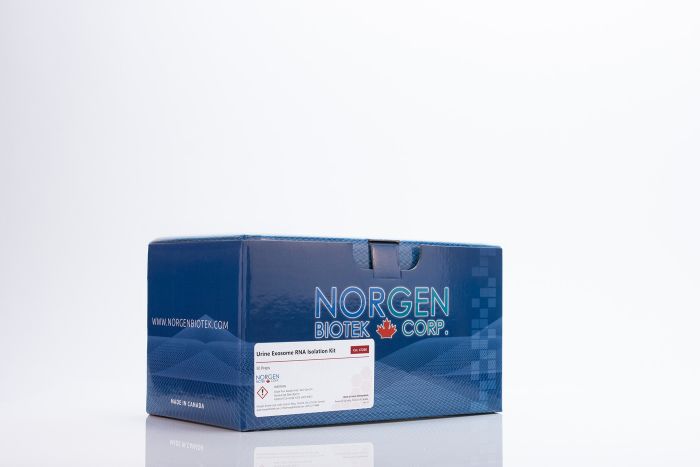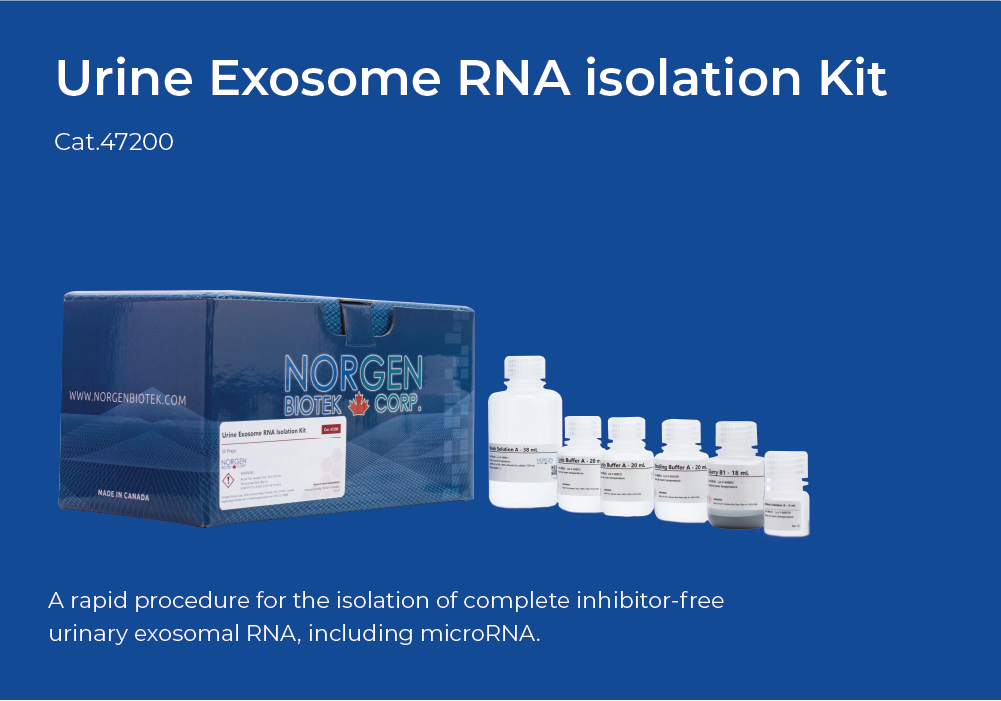Cancer is the second leading cause of death in both men and women worldwide. In 2020, 1.41 million people were diagnosed with prostate cancer worldwide.1 With over 300,000 deaths caused by prostate cancer in 2022, early detection is crucial for reducing mortality.14 Recently, exosomal RNA has garnered significant attention as a source of potential biomarkers for early detection of cancer such as breast cancer, liver cancer, and prostate cancer.12,13 The prostate is a small walnut-shaped gland located below the bladder and in front of the rectum. It is responsible for producing seminal fluid that transports sperm.

There are several types of prostate cancer, the most common type being adenocarcinoma. Some other types of prostate cancers include small cell carcinoma, sarcomas, neuroendocrine tumors, and transitional cell carcinoma. Prostate cancer tends to progress very slowly and progresses locally in the prostate during the early stage. 3 This makes detection of the disease at an early stage challenging. However, if found early, the cancer is highly treatable and often can be eliminated. This blog will discuss the symptoms and risk factors of prostate cancer, screening methods, the importance of exosomal mRNA, and lastly, two studies exploring the potential for exosomal mRNAs as a non-invasive biomarker for early prostate cancer screening.
Urine Exosome RNA Isolation Kit

Discover exosomal mRNA biomarkers for prostate cancer with our Urine Exosome RNA Isolation Kit.
Learn MoreProstate Cancer Risk Factors

In the early stages, there may not be any signs or symptoms due to the slow-growing nature of the cancer. However, several symptoms may appear in the later stages of cancer development. Some of them include trouble urinating, increased urinary urgency and frequency, blood in urine, blood in semen, bone pain, reduced force of the stream of urine, erectile dysfunction, and weight loss.
The causes of prostate cancer are still unknown, similar to many cancers. However, there are several known risk factors associated with the disease. For example, age (being 50 years or older), family history (history of prostate cancer), and weight (obesity) have all been connected to the development of prostate cancer 4. Race also plays a role in increasing the chances of developing cancer. A study in 2023 stated that black men are at higher risk of prostate cancer than non-Hispanic white Americans. This could be due to genetics, differences in diets, or added stress.5
Screening Methods for Prostate Cancer
According to the Centers for Disease Control (CDC), a biopsy is the most common way to diagnose prostate cancer.6 A prostate biopsy is when a small sample of the prostate tissue is removed for further analysis. A needle is inserted into the prostate to collect several samples of the suspicious tissue. This method of diagnosis is highly invasive, painful, and uncomfortable.
However, before a prostate biopsy, several preliminary confirmation screening tests are performed. Some of these tests include a digital rectal exam (DRE), prostate-specific antigen (PSA) blood test, transrectal ultrasound, and magnetic resonance imaging (MRI). 7 PSA blood test is the most common method of screening for prostate cancer. The test measures the amount of prostate-specific antigen (a protein) present in the body. When an individual develops prostate cancer, they have an elevated amount of PSA. Although a common test for the screening of prostate cancer, the PSA blood test can be unreliable as there are several other reasons why an individual might have elevated levels of this protein. Normal prostate cells produce PSA, therefore, benign (non-cancerous) conditions such as prostatitis (inflamed prostate) and benign prostatic hyperplasia (BPH) (enlarged prostate) can increase the levels of PSA in the blood.8 Additionally, activities such as vigorous exercise, ejaculation, or even a car accident can also elevate PSA levels. The unreliability of the PSA blood test and the invasive nature of a biopsy necessitates a more reliable, non-invasive approach to prostate cancer detection. Recently, exosomal mRNAs have piqued significant attention among researchers as a potential biomarker for prostate cancer detection. The sample collection for exosomal mRNA is significantly less invasive as exosomes can be found in bodily fluids. Furthermore, exosomal mRNAs can provide more accurate and reliable results compared to the blood PSA tests due to the specificity of the testing.
Understanding mRNA and Exosomes
What is mRNA?
Messenger RNA (mRNA) is a single-stranded molecule that plays a crucial role in protein synthesis. Transcribed from a DNA template, mRNAs carry protein-coding information from a cell’s nucleus to the cytoplasm.9 Studying mRNA provides valuable insights into cellular functions, gene expression, and specific mutations associated with diseases such as cancer.
What are exosomes?
On the other hand, exosomes are extracellular vesicles (EVs) that are secreted by various cell types and found in saliva, plasma, urine, and other bodily fluids. These vesicles are enclosed by a lipid bilayer, and carry a diverse range of biomolecules, including nucleic acids and proteins, inside as well as on their surface. Exosomes are critical for cell-to-cell communication, cellular maintenance, and tumor progression. 10 Exosomes carry information from all cells, including healthy and diseased, making them valuable in understanding disease mechanisms and developing diagnostics or therapeutics.
Biomarkers for cancer
Circulating exosomal mRNA
A study in 2021 set out to characterize circulating exosomal mRNA in order to explore their potential as biomarkers for prostate cancer. Exosomes can be found all over the body and they may contain different information based on their location. To demonstrate that exosomal mRNAs are able to provide the same accurate results as cell cancerous prostate tissue, the researchers compared tissue mRNA with circulating exosomal mRNA from blood via RNA sequencing. They found that both mRNA from prostate cancer tissue cells and circulating exosomal mRNA reflected the same information. They obtained samples from 76 prostate cancer patients and 84 patients with BPH. After a series of analyses via RNA sequencing, they identified 6 upregulated circulating exosomal mRNAs that showed significant differences in expression levels between the prostate cancer patients, BPH patients, and the control group.2 This showed significant promise that circulating exosomal mRNA can be used as a biomarker for the detection of prostate cancer. This study was based on blood samples as circulating exosomes can be found in the blood and plasma. However, that is still not completely non-invasive. Is there a completely noninvasive way to detect prostate cancer? Yes, a more recent study from 2024 explores using urinary exosomal mRNA to detect prostate cancer. Which is what we cover next.
Urinary exosomes mRNA
Jiayin Yu et. al. investigated the “use of urinary exosomal mRNAs as a potential biomarker for early detection of prostate cancer”. Let’s talk about why they picked urinary exosomal mRNA. Firstly, they chose urine due to the convenient, noninvasive sample collection process which makes it ideal for mass screening and early detection. Secondly, exosomal mRNA was analyzed because of its stability in the body. Due to the lipid bilayer of exosomes, the genetic information inside is protected from degradation by nucleases.
Next Generation Sequencing of Urinary Exosomal RNA
Key mRNA Biomarkers Identified for Prostate Cancer Screening
The study revealed, “Top 10 mRNAs exhibiting the most significant differences associated with prostate cancer were selected as candidate genes. These genes included RAB5B, WWP1, MCF2L, HIST2H2BF, ZFY, MARK2, PASK, RBM10, NRSN2, and PCGF1”. Subsequent qPCR and electrophoresis identified 8 of these mRNAs (RAB5B, WWP1, HIST2H2BF, ZFY, MARK2, PASK, RBM10, and NRSN2) as superior to blood PSA as an indicator of prostate cancer. The study concluded that their comprehensive model of urinary exosomal mRNAs outperformed traditional PSA screening methods with a sensitivity of 70-90% and a specificity of 20-40%.

The analysis revealed, “Top 10 mRNAs exhibiting the most significant differences associated with prostate cancer were selected as candidate genes. These genes included RAB5B, WWP1, MCF2L, HIST2H2BF, ZFY, MARK2, PASK, RBM10, NRSN2, and PCGF1”. Upon conducting qPCR and electrophoresis, 8(RAB5B, WWP1, HIST2H2BF, ZFY, MARK2, PASK, RBM10, and NRSN2) of the 10 mRNAs were identified and proven to be superior to blood PSA as an indicator of prostate cancer. The study concluded that their comprehensive model of urinary exosomal mRNAs is a better method for prostate cancer screening with a 70-90% sensitivity and 20-40% specificity.11
Summary
Overall, prostate cancer is one of the leading causes of death for men. Although there are several methods of screening prostate cancer, such as DRE or blood PSA test, they are invasive and unreliable. This calls for the need to identify a non-invasive, more accurate, and reliable method for screening prostate cancer. Current research using urinary exosomal mRNA shows promising results for the early detection of prostate cancer. Further research is needed to firmly establish urinary exosomal mRNAs as a tool for prostate cancer diagnosis. With that being said, here at Norgen Biotek we are ready to help advance research with our urine exosome kits such as Urine Exosome RNA Isolation Kit and Urine Exosome Purification and RNA Isolation Kits.






